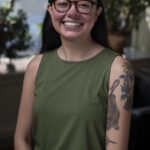
Meet Camilla Sandoval ’17, history, M.A. ’19, historical studies, a first-generation student who spent part of her time on each of UMBC’s campuses before graduating and putting her studies to work. Today, she spends her days as the program coordinator for grants with Maryland Humanities, where she still employs lessons learned from her time as a Retriever. Thanks for sharing your story, Camilla!
Q: Briefly introduce yourself. What’s one essential thing you’d want another Retriever to know about you?
A: I am a first-generation college student, and I studied history and public history at UMBC’s Shady Grove campus (for my bachelor’s) and main campus (for my master’s). Both experiences were instrumental to my professional and personal growth. It was at UMBC where I started recognizing the humanities as a tool for community empowerment.
Q: What’s the one thing you’d want someone to know about the support you find here?
A: It was hard for me to accept when I had to ask for help—especially when I didn’t know what I didn’t know. But once I did, I found enormous support in my professors and in my cohort. They helped the academic experience feel less isolating and pushed me to believe in myself as much as they believed in me.

“This is me at Rocky Mountain National Park in August 2017, the summer between my undergraduate and graduate programs. I was there as part of the Latino Heritage Internship Program. Thank you to Dr. Melissa Blair for sharing the internship with me and helping with my application. This trip to Colorado has been one of the most rewarding experiences for me.”
Q: Where do you work? What do you enjoy most about it?
A: I’m currently the program coordinator for grants at Maryland Humanities, our state humanities council. In my role, I’m part of our grantmaking efforts. I’m able to help small humanities organizations across the state get access to funding that can be used for general operating expenses. I get the most joy out of hearing our grant recipients talk about using funds to continue preserving their local history or being able to keep their doors open for the communities they serve.
“The history department at both UMBC- Shady Grove and the Catonsville campus were the biggest difference makers in my education and they have continued to support me in my professional career.
Camilla Sandoval ’17, history, M.A. ’19
Q: Tell us about your primary WHY, and how it led you to UMBC.
A: I came to UMBC because it was my best opportunity to study my field of interest while staying close to my family. I came with the hope of finding guidance and direction. I always loved history and knew it was important for understanding myself and the world, but I needed to learn how that translated into a career in which I could use the skills to support and lift up my community and culture. My family and community gave me everything they could, and I was committed to setting myself up on a career path in which I could contribute back in any way I could.
 “
“This is my mom and me at my master’s graduation on main campus in May 2019. My family here in the U.S. and in El Salvador has always been the most important and supportive part of my life. I am where I am today because of my mom.”
Q: Tell us about the people who helped you grow at UMBC, and why their HOW made such a difference to you.
A: My time at UMBC introduced me to new ideas and opened opportunities I didn’t know existed, and helped me out of my comfort zone to develop my skills. I left with deeper appreciation for history and a better belief in myself. My history and public history professors were especially impactful. They guided me as a first-generation college student, encouraged me to consider going for my master’s degree, and led me to internships that served as critical stepping stones in my career. The history department at both UMBC- Shady Grove and the Catonsville campus were the biggest difference makers in my education and they have continued to support me in my professional career.
* * * * *
UMBC’s greatest strength is its people. When people meet Retrievers and hear about the passion they bring, the relationships they create, the ways they support each other, and the commitment they have to inclusive excellence, they truly get a sense of our community. That’s what “Meet a Retriever” is all about.





